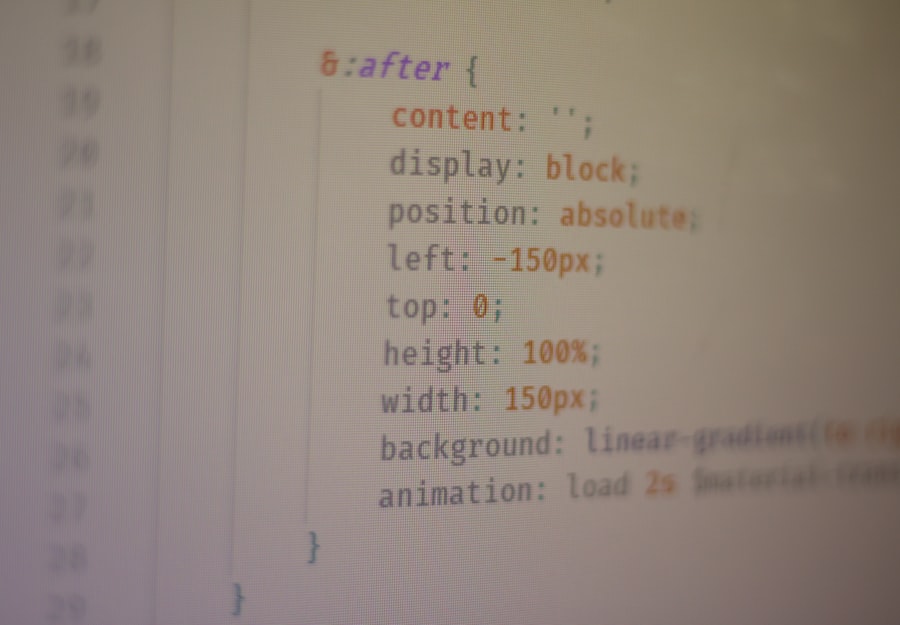In the ever-evolving landscape of web development, the significance of auditing unused CSS and JavaScript cannot be overstated. As I delve into this topic, I realize that many developers often overlook the impact that extraneous code can have on a website’s performance. Unused CSS and JavaScript not only bloat the size of web pages but also contribute to longer loading times, which can deter users and negatively affect search engine rankings.
By taking the time to audit and remove this unnecessary code, I can enhance the overall user experience and ensure that my website operates at peak efficiency. Moreover, the importance of maintaining a clean codebase extends beyond mere performance metrics. A streamlined codebase is easier to manage, debug, and update.
When I eliminate unused styles and scripts, I create a more organized environment that fosters collaboration among team members. This practice not only simplifies future development efforts but also reduces the likelihood of introducing new bugs or issues. Ultimately, understanding the importance of auditing unused CSS and JavaScript is a crucial step toward building a robust and efficient web application.
Key Takeaways
- Auditing unused CSS and JavaScript is important for optimizing website performance and improving user experience.
- Identifying unused CSS and JavaScript in your codebase can be done using various tools and techniques, such as browser developer tools and code analysis tools.
- Tools like PurifyCSS, UnCSS, and Chrome DevTools can help in auditing and removing unused CSS and JavaScript from your codebase.
- Best practices for removing unused CSS and JavaScript include using a modular approach, leveraging build tools, and regular code reviews.
- Unused CSS and JavaScript can impact website performance by increasing page load times and affecting user interactions.
Identifying Unused CSS and Unused JavaScript in Your Codebase
Identifying unused CSS and JavaScript in my codebase is a task that requires a keen eye and a systematic approach. The first step I take is to analyze my stylesheets and scripts to determine which elements are not being utilized. This often involves reviewing the HTML structure of my web pages and cross-referencing it with the styles and scripts that are loaded.
I find that tools like browser developer tools can be incredibly helpful in this process, as they allow me to inspect elements and see which styles are applied or ignored. Another effective method for identifying unused code is to utilize coverage tools available in modern browsers. For instance, Chrome’s DevTools offers a coverage feature that highlights unused CSS and JavaScript as I navigate through my site.
By recording a session while interacting with my website, I can pinpoint exactly which lines of code are never executed or applied. This not only streamlines my auditing process but also provides me with concrete data to support my decisions when it comes to removing unnecessary code.
Tools and Techniques for Auditing and Removing Unused CSS and Unused JavaScript

When it comes to auditing and removing unused CSS and JavaScript, I have discovered a variety of tools and techniques that make the process more efficient. One of my go-to tools is PurifyCSS, which scans my HTML files and extracts only the styles that are actively used. This tool allows me to significantly reduce the size of my CSS files without sacrificing design integrity.
Additionally, I often turn to UnCSS, which automates the removal of unused styles by analyzing my HTML files against my CSS. For JavaScript, I find that tools like Webpack’s tree-shaking feature are invaluable. Tree-shaking allows me to eliminate dead code from my JavaScript bundles by analyzing the import statements in my modules.
This not only reduces file size but also enhances load times, making my web applications more responsive. Furthermore, I often employ linting tools such as ESLint to identify unused variables or functions in my JavaScript code, ensuring that I maintain a clean and efficient codebase.
Best Practices for Removing Unused CSS and Unused JavaScript
As I embark on the journey of removing unused CSS and JavaScript, I have learned several best practices that help streamline the process. First and foremost, I always make sure to back up my original files before making any changes. This precautionary step ensures that I can easily revert to the previous version if something goes awry during the removal process.
Additionally, I prefer to work in a staging environment where I can test changes without affecting the live site. Another best practice I adhere to is to remove unused code incrementally rather than all at once. By taking a phased approach, I can monitor the effects of each change on my website’s functionality and performance.
This method allows me to catch any potential issues early on, making it easier to troubleshoot if something breaks. Furthermore, I make it a point to document any changes I make, noting which styles or scripts were removed and why. This documentation serves as a valuable reference for future development efforts.
Impact of Unused CSS and Unused JavaScript on Website Performance
The impact of unused CSS and JavaScript on website performance is profound and multifaceted. From my experience, one of the most immediate effects is increased loading times. When users visit a website laden with unnecessary code, they often encounter longer wait times as their browsers struggle to download and parse these files.
This delay can lead to higher bounce rates, as users are less likely to wait for a slow-loading page to display its content. Moreover, unused code can hinder a website’s responsiveness. As I optimize my web applications, I’ve noticed that reducing the amount of unused CSS and JavaScript leads to smoother interactions and faster rendering times.
This improvement not only enhances user satisfaction but also positively influences search engine optimization (SEO). Search engines prioritize fast-loading websites in their rankings, so by minimizing unused code, I am effectively boosting my site’s visibility in search results.
Common Mistakes to Avoid When Removing Unused CSS and Unused JavaScript

While removing unused CSS and JavaScript is essential for optimizing performance, there are common pitfalls that I strive to avoid during this process. One major mistake is removing code without thoroughly testing its impact on the website’s functionality. In my early days of development, I learned the hard way that even seemingly insignificant styles or scripts could be crucial for specific features or layouts.
To mitigate this risk, I always conduct comprehensive testing after making any changes. Another mistake I often see developers make is failing to consider browser compatibility when removing code. Some styles or scripts may be necessary for certain browsers or devices, even if they appear unused in others.
To avoid this issue, I ensure that I test my website across various browsers and devices after making adjustments. This practice helps me maintain a consistent user experience for all visitors, regardless of how they access my site.
Testing and Verifying the Effects of Removing Unused CSS and Unused JavaScript
Testing and verifying the effects of removing unused CSS and JavaScript is a critical step in ensuring that my optimizations yield positive results. After making changes, I conduct thorough testing across different devices and browsers to confirm that all functionalities remain intact. This includes checking interactive elements such as buttons, forms, and navigation menus to ensure they operate as intended.
In addition to functional testing, I also monitor performance metrics using tools like Google PageSpeed Insights or GTmetrix. These tools provide valuable insights into loading times, page size, and overall performance scores before and after my optimizations. By comparing these metrics, I can quantify the impact of removing unused code on my website’s performance, allowing me to make informed decisions about future optimizations.
Continuous Monitoring and Maintenance of CSS and JavaScript to Prevent Accumulation of Unused Code
The journey toward an optimized web application doesn’t end with a one-time audit; continuous monitoring and maintenance are essential to prevent the accumulation of unused CSS and JavaScript over time. As I develop new features or make updates to my website, I remain vigilant about the potential for introducing unnecessary code. Regularly revisiting my codebase allows me to identify any new instances of unused styles or scripts before they become problematic.
To facilitate ongoing maintenance, I have adopted a routine where I schedule periodic audits of my CSS and JavaScript files. This proactive approach ensures that I stay ahead of any potential performance issues while keeping my codebase clean and efficient. Additionally, fostering a culture of code cleanliness within my development team encourages everyone to prioritize optimization efforts as part of our workflow.
In conclusion, auditing unused CSS and JavaScript is an essential practice for any web developer seeking to enhance website performance and user experience. By understanding its importance, employing effective identification techniques, utilizing appropriate tools, adhering to best practices, avoiding common mistakes, testing thoroughly, and committing to continuous maintenance, I can ensure that my web applications remain efficient and responsive in an ever-changing digital landscape.
